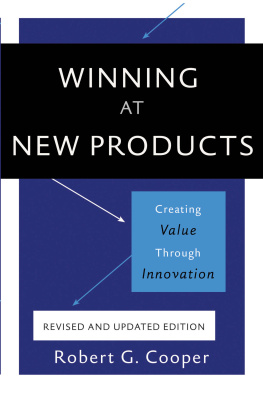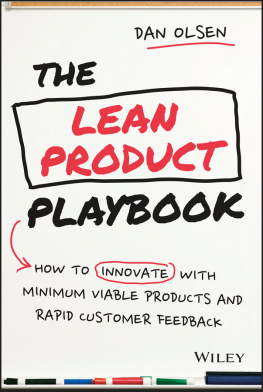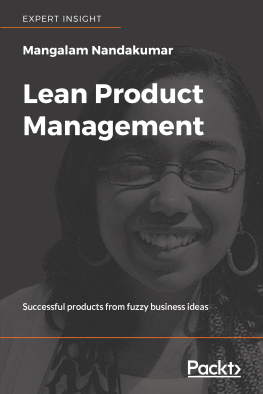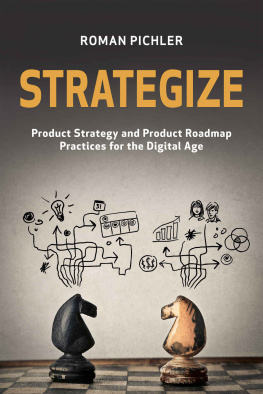Copyright 1988, 1993, 2001, 2011, 2017 by Robert G. Cooper
Hachette Book Group supports the right to free expression and the value of copyright. The purpose of copyright is to encourage writers and artists to produce the creative works that enrich our culture.
The scanning, uploading, and distribution of this book without permission is a theft of the authors intellectual property. If you would like permission to use material from the book (other than for review purposes), please contact permissions@hbgusa.com. Thank you for your support of the authors rights.
Basic Books
Hachette Book Group
1290 Avenue of the Americas, New York, NY 10104
www.basicbooks.com
First Edition: September 2017
Published by Basic Books, an imprint of Perseus Books, LLC, a subsidiary of Hachette Book Group, Inc.
The Hachette Speakers Bureau provides a wide range of authors for speaking events. To find out more, go to www.hachettespeakersbureau.com or call (866) 376-6591.
The publisher is not responsible for websites (or their content) that are not owned by the publisher.
Library of Congress Control number: 2017949583.
ISBNs: 978-0-465-09332-8 (2017 paperback), 978-0-465-09333-5 (ebook)
E3-20170810-JV-NF
CONTENTS
Navigation
To the three ladies in my life:
My wife, Linda, and my two daughters, Barbara and Heather
In memoriam
Jens Arleth,
managing director of U3-Innovation Management, Copenhagen
A leading innovator and a good friend
Stage-Gate has become the most widely used method for conceiving, developing, and launching new products in industry today. Stage-Gate is much more than a business process, however. The model was originally conceived by observing successful product developers as they drove major innovations to market. Those early observations led to the conclusion that there was a better waythat some innovation teams and project leaders had intuitively figured it out. I tried to capture their secrets to success on paper, and so was born the Stage-Gate system. Thus Stage-Gate is an idea-to-launch process, but one that encompasses a body of knowledge and set of best practicesbest practices based on studies of thousands of successful new-product developments and hundreds of companies that probed what the winners do differently from the rest.
The emphasis in this 5th edition of Winning at New Products is on bold innovation and in record time. Ive watched as companies, a few industries excepted, have shifted their innovation efforts from true innovations and major projects to much smaller and less ambitious ones over the last few decades. Its somewhat disheartening to see what these companies are calling innovation versus what it should be. In some firms, product development has been totally trivialized. I hope this 5th edition sounds a wake-up call that true innovation and bold product development are within your grasp.
I also emphasize speedmore specifically, agility, flexibility, and acceleration and adaptability, which are all linked. It seems that too many firms innovation processes have become rigid and bureaucratic over the yearsslow and cumbersome, unable to deal with todays pace of change. Its as though theyre designed to impede bold innovation and to stand in the way of doing anything worthwhile fast. And so I build in some new techniquessome from the IT worldto get the innovation engine up to speed to where it should be: agile, accelerated, adaptive, and flexible.
The 1st edition of this book was published in 1986, before I had even begun to use the term stage-gate. That first book reported the results of a number of research studies that colleagues and I had undertaken into new product success and failure. And it proposed the use of a systematic and gated idea-to-launch business process for the first time. To my surprise, the book had a profound impact on the way many companies approached product development, and firms such as P&G, DuPont, and Exxon Chemicals immediately embraced the concept of my stage-and-gate system.
But those were the early days of management of the innovation process. More research was undertaken, including some that focused on these early adopters of Stage-Gate. More success factors were uncovered in our NewProd research series and in our major benchmarking studies that followed; and more experiences were gained with the use of Stage-Gate methods (I first used the term Stage-Gate in an article that appeared in the Journal of Marketing Management in 1988). And so the 2nd edition was published in 1993. It went on to become the bible for those businesses trying to overhaul their new product process and implement Stage-Gate. The 3rd edition in 2000 continued the tradition, but with an emphasis on accelerating idea-to-launch. And the 4th edition in 2011 built in many of the new approaches, such as spiral or iterative development, lean processes, and open innovation, that are widely embraced today.
This current 5th edition is more than a simple updating of the 4th edition, howevermuch in it is new too. Six years have passed since I wrote the last edition, and much more has been learned: For example, Agile development methods have gained a solid foothold in the IT or software-development world, and in the last few years have been employed within Stage-Gate and for physical or manufactured new products, achieving dramatic results. Indeed, incorporation of Agile methods as a project-management tool within the stages of Stage-Gate may be the most significant change to my durable gating system since it was first developed thirty years ago!
Stage-Gate has evolved and morphed in other ways tooit continues to be an evergreen process because of its many users globally! With these thousands of users, its inevitable that new twists, approaches, and methods are uncovered, tested, proven, and incorporated into their idea-to-launch systems. Many of these novel approaches find their way into this book too. Stage-Gate is now faster and more streamlineduser firms have borrowed the concepts of lean manufacturing and Six Sigma and built these into Stage-Gate. Portfolio management has been integrated with gating methods, and the concept of lean gates and gates with teeth have been fashioned into the system in order to make sharper and more effective investment decisions. Stage-Gate has been made more adaptive and flexible in some firms, and its now context based and risk dependent. Its also been automated with robust software. And there are new tools, such as Design Thinking and the Innovation Project Canvas, that have been built in as well. Further, Stage-Gate approaches have even been extended to other types of projects, including technology developments (fundamental science) and process developments. So much thats new makes todays Stage-Gate hardly recognizable by early adopters of the original process! All of these new concepts and methods are in this latest edition.
Finally, this 5th edition takes a more holistic approach to succeeding at product innovation. There is more to winning than simply having a solid or agile idea-to-launch process! This holistic or systems approach is introduced in the Innovation Diamond, which includes strategy, resource and portfolio management, climate and culture, and process. Thus a new chapter on innovation strategy is built into this edition; and portfolio managementmaking the right investment decisionsis heavily emphasized too. And achieving the right climate and culture is a theme woven throughout.










